The end of October is here and the 31st is just days away. If dressing up and trick-or-treating is not your family’s kind of thing, but you would still like to experience Halloween horror – I have selected the 7 best Halloween board games, that will get you into the right holiday spirit.
Introduction to 7 Best Halloween Horror Board Games in 2023
In my research, I considered these three factors to be the most important:
- An ideal player number should be 4, or around 4 as this is a “standard” family size.
- Playing time should be appropriate for one evening game – just right to sit down together after dinner and be done by a reasonable hour.
- Games should offer some challenge, but they should still be accessible for the whole family – but some pre-experience with board games is needed and it helps if one or two family members have a bit more experience. So, moderately complex board games.
Below are the board games, that I selected in no particular order. To find out which one is my favorite, check out the Conclusion.
Click here to read my short horror-story, based on Killslash, a journaling board game.
Table of Contents
You can quickly navigate through the article by clicking on the titles below.
- Elder Sign
- Mysterium
- Ghost Stories
- Pandemic: Reign of Cthulhu
- Zombicide
- Mansions of Madness (Second Edition)
- Betrayal at House on the Hill
- Bonus entry – check it out!
- Conclusion
If you click on an affiliate link, you will be taken to the Amazon store – if you then buy something, I will earn a commission. I am a member of the Amazon Associates program.
Elder Sign

Players: 1 to 4, ideal for 4
Playing time: 90 minutes
Complexity/Ages: 12+
Placed in the Lovecraftian Arkham Horror universe, Elder Sign is a cooperative dice-rolling game.
The game is set in a museum, where several bizarre events have been reported recently. One of the Ancient Ones is trying to return to our dimension and it’s the task of the investigators to stop him by either sealing him away or, if that fails, defeating him in combat.
The Ancient Ones are coming
The Ancient One is chosen randomly for each game out of eight possibilities, the most famous of them being Chtulhu. Sealing him is done by collecting elder signs, before “he” collects all of his doom tokens.
Each Investigator also plays slightly differently: it has its personality, special ability, sanity, stamina, and specific starting items.
Signs are collected by carefully selecting an adventure from the board (six randomly drawn out of 48) and then rolling the dice to fulfill the requirements: a certain number and combination of symbols on the dice you’ve got to throw.
The game is luck-dependent, but not entirely, since there are items and spells you will collect during the game that can give you better odds at rolling: use more dice, lockdown certain dice, add to the rolled value, switch certain symbols with others, etc.
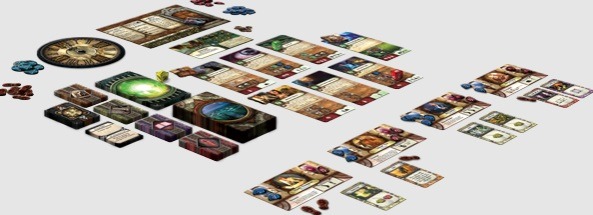
A lot of fun for the whole family
After an adventure is completed, the player receives the mission card and a new one is drawn in its place. He also receives all the rewards, listed on the card. Rewards may contain items, spells, clue tokens, elder signs, etc.
Should an adventure fail, you must take penalties (also listed on the cards): lose sanity or stamina, summon a monster or add a doom token.
It all adds up to fast-paced gameplay and is fairly simple to play, ideal for family gatherings. In addition to the base game, there are numerous expansions available.
Mysterium
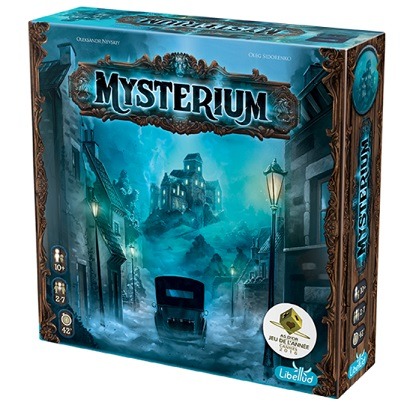
Players: 3 to 7, ideal for 5-6
Playing time: 42 minutes
Complexity/Ages: 8+
When Mr. MacDowell, a talented astrologer, buys a new house, he detects the presence of a supernatural being, a ghost. Quickly he gathers his friends, also mediums, and they try to communicate with the ghost.
Soon they learn that it’s a ghost of a man who was murdered and that the murder is, to this day, still unsolved. The ghost is trying to communicate with them, but he has trouble communicating – in fact, he has trouble even remembering the tragic evening. Will you be able to help him and solve the mystery of his murder?
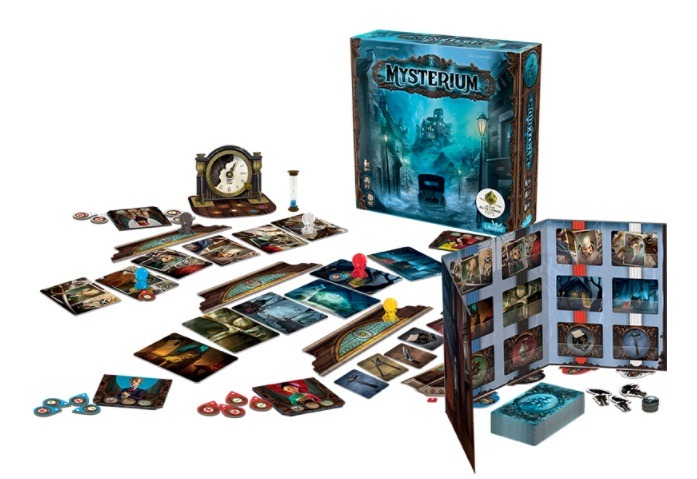
Pictures speak louder than words
Mysterium is an asymmetric cooperative game. One of the player plays as a ghost of a murdered man, while other players play as mediums, communicating with him. The objective of the game is to find the victim’s killer, his weapon, and the location of the murder so that the ghost can rest in peace.
But the ghost cannot speak directly, he can only give out clues (cards) to players. In a series of rounds, players try to put together the clues, and if, in the end, the majority guesses correctly, the ghost is saved.
Game rules are easy to understand and easy to learn. I suggest putting the most experienced player as the ghost so that other players pick the game up even faster. Although it’s completely fine for four players, an extra player or two only enhances the experience.
Ghost Stories
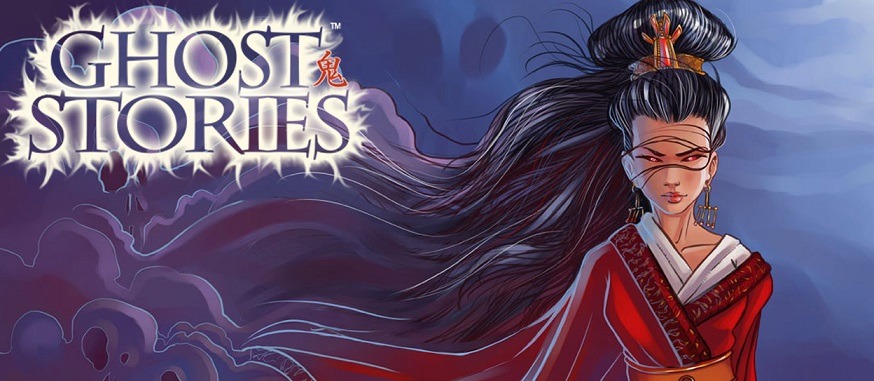
Players: 1 to 4, ideal for 4
Playing time: 60 minutes
Complexity/Ages: 12+
Our next item on the menu is set in ancient China, where a group of monks is trying to protect a village from Wu-Feng, the incarnation of the devil and his legions, who haunt the village and try to return Wu-Feng to the physical world.
To win, players must defeat Wu-Feng. If enough of the village tiles get haunted, if the draw pile empties, or if all players die, Wu-Feng wins and the players lose.
Monks work together (it’s a cooperative game) against the forces of the game.
The village is made of a 3×3 board, with monsters coming in waves to tiles around it. There are various ghosts, each having a special ability, that affect players in different ways, harming them, disrupting their dice rolls, or blocking tiles.
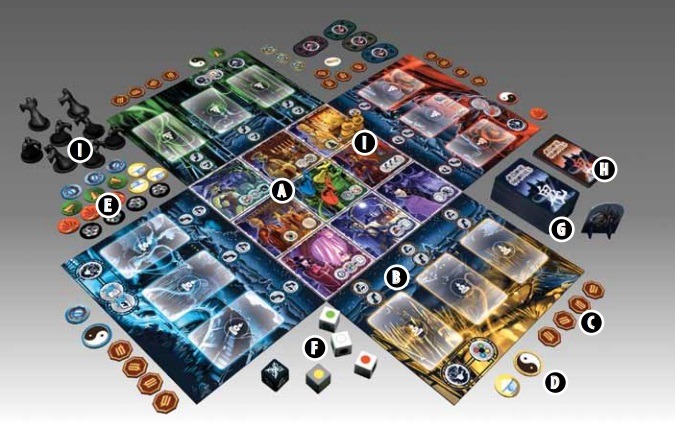
Hell is here
Players have options to move on the tiles, use their abilities and exorcise monsters by rolling dice. Dice rolls can be enhanced by the use of tokens, so it’s not all down to luck, although it plays a part.
Instead of exorcising, players also have the option to use a tile in the village (if it’s not haunted). Tiles have different bonuses: revive a fellow player, recover tokens, get traps, move ghosts, or un-haunt other tiles.
When the ghosts are defeated, Wu-Feng himself incarnates and must be defeated (more than once, if you play higher difficulties) to win the game. That is, if you last that long, as Ghost Stories is quite tough, especially on higher difficulties.
Pandemic: Reign of Cthulhu
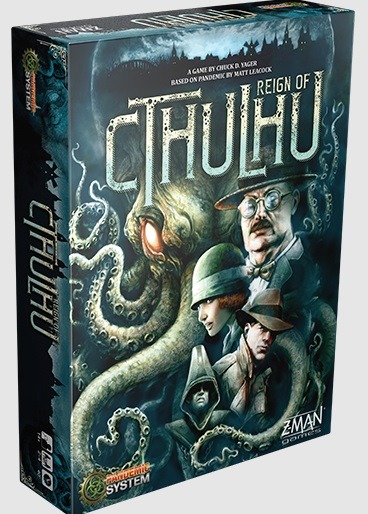
Players: 1 to 4, ideal for 4
Playing time: 40 minutes
Complexity/Ages: 10+
Loving Lovecraft
This is Pandemic in Lovecraft’s fantasy world (the same world as in Elder Sign and Mansions of Madness)
The world map is replaced: instead of continents, it’s divided into cities: Arkham, Dunwich, Innsmouth, and Kingsport. Locations such as Church, Cafe, University, Police Station, Secret Lodge, Historic Inn, Market, Theater, Hospital, and others replace cities.
Replacing diseases, are the figures of cultists (they take 1 action point to remove, just like diseases) and larger Shoggoths, which take 3 action points to remove.
Summoning cards (with location names) are used for cult spreading. Besides these, there are four types of Clue cards (4 cities). This makes traveling and sharing cards much easier and more convenient for players.
It’s all about those action-points
Each turn, a player gets four action points. He can use them for
- movement (either directly, with help of Clue cards, or through gates),
- defeat a cultist for one action point,
- defeat a Shoggoth for 3 action points,
- give or take Clue or Relic cards or
- seal a gate.
Next, it’s time to draw 2 cards from the deck. This deck includes:
- remaining Clue cars, together with
- Relic cards (one-time special ability cards) and
- dreaded Evil Stirs cards. Evil Stirs cards make you
- roll the insanity die,
- awake another Old One (if the last one in line – Cthulhu awakens, you lose),
- summon another Shoggoth and reshuffle cultist summoning cards, placing them back on deck.
The final stage of the turn is the Summoning. Cards are drawn to summon more cultists (like spreading diseases in the original Pandemic) and, depending on the cards, Shoggoths may move or one of the Old Ones is awakened.
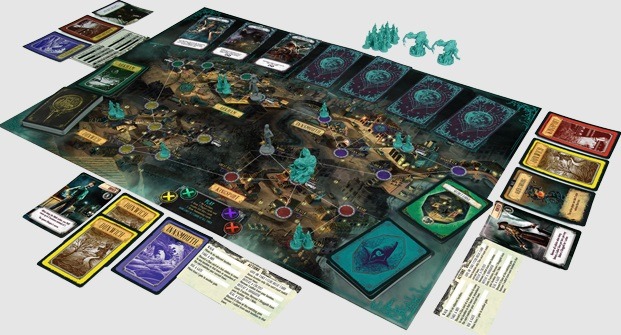
Keep your sanity
If by throwing the insanity die, one of the player characters receives enough insanity tokens, he becomes insane, reducing his action points and special abilities. If all of the characters become insane, the game is lost. Insanity can be cured by sealing a gate.
Sealing a gate can be done by being on a gate location and using 5 matching Clue cards of the town, the gate is in. When all four gates are sealed, the players win the game.
Bottom line, Pandemic: Reign of Cthulhu is a very good theme implementation over proven Pandemic game mechanics with slight alterations, which only make the whole experience better.
If you like the idea of a cooperative game like Pandemic (or its relative, Forbidden Island) in a popular horror theme, you will love Call of Chtulhu.
Zombicide

Players: 1 to 6, ideal for 3
Playing time: 60 minutes
Complexity/Ages: 10+
You can’t have a good horror without zombies these days. If they are your thing, then this is your game. There are plenty of zombie-themed board games out there, but Zombicide is perhaps the most popular and successful cooperative zombie-killing game.
Zombie games for all of us
In fact, after the original crowd-funded title in 2012, it has become a whole franchise of numerous alone-standing board games and expansion. The most prominent core titles are:
- the original Zombicide from 2012,
- Zombicide: Prison Outbreak (2013): with more close-up melee brawls,
- Zombicide: Rue Morgue (2015): introducing more powerful zombies,
- Zombicide: Black Plague (2015): zombies in the middle ages,
- Zombicide: Green Horde (2018): fantasy world fighting orcs and goblins,
- Zombicide: Invader (2019): aliens as zombies,
- Zombicide: Second Edition (2020).
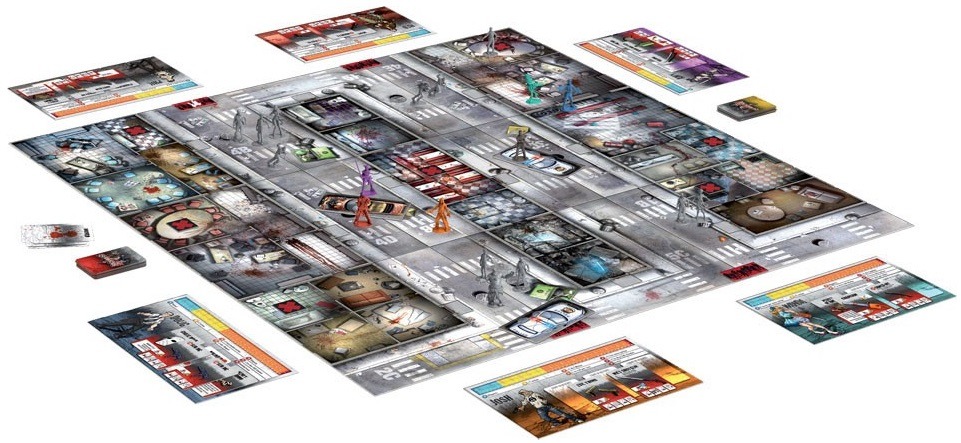
As close as you can get to a Hollywood action movie
They all use slightly adapted game mechanics and all of them are well-received by the community. You can’t go wrong with any of them, but if I had to recommend just one, I’d say start with the original game and go from there.
Each player takes the role of a survivor with a different skill set. Moving on the (modular) board, finding weapons – and then using them wisely along with your abilities to kill zombies is your job. Zombies are controlled by the game (a deck of cards) and, although not very smart, outnumber you by a lot.
Can you survive in a post-apocalyptic zombie-infested world? Will you kill or be killed?
Mansions of Madness (Second Edition)
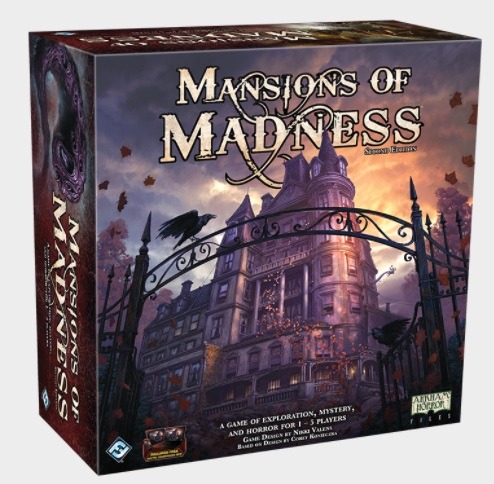
Players: 1 to 5, ideal for 3 or 4
Playing time: 2 to 3 hours
Complexity/Ages: 12+
This is another cooperative horror game, that takes place in Lovecraft’s world. It was first published in 2011. In 2016, the revised Second Edition came out.
It’s all about the app
What makes Mansions of Madness: Second Edition special, is the iOS/Android/Steam app, which keeps track of all parameters (like your or your enemy hit points), guides you on how to build the map, controls the monsters, etc. It takes the role of the keeper from the First Edition, which required a human to play it. Now, that player is free to play the game, instead of running it.
Numerous expansions are available. These add more scenarios and new investigators, monsters, map tiles, tokens, and cards. You can find the complete list on Wikipedia, together with information on the difficulty level of each scenario and how long it takes to complete it.
How to play
Mansions of Madness is played over several rounds. Each round consists of two phases: the players’ turns (Investigator phase) and the game’s (app’s) turn (Mythos phase).
After the scenario is set up (by the instructions), all players start at the designated point. In their turn, players get two action points, with which they can:
- Move 2 spaces,
- Explore (revealing another tile),
- Search (if there is a searchable location on the map),
- Trade items or spells with other players,
- Interact with an object (like barricades, fires, secret passages, or darkness) or person,
- Perform Component cards actions (as described on the card) and
- Attack a monster.
The game strikes back
In the Mythos phase the game will:
- perform scenario-specific events,
- activate monsters and
- perform horror checks for nearby monsters (each monster has a horror rating) – insanity is possible.
During the investigation or Mythos phase, the game will throw interactive challenges toward players: different types of puzzles, solvable on the app.
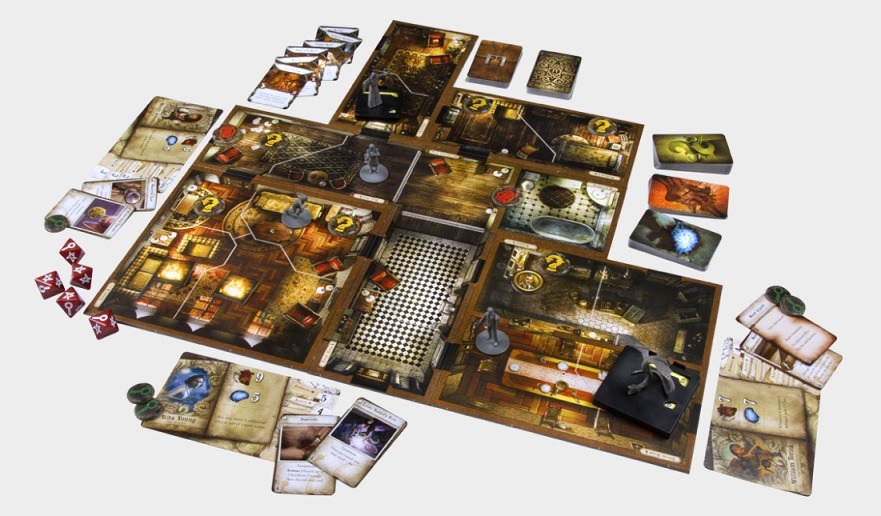
Each scenario has a different object for winning, which is discovered during play. It is in the best interest of Investigators to discover this as soon as possible (following the narrative and searching for clues) and complete it – if they take too long, the game wins. Or if everyone dies, the game wins as well.
Immersive theme and a ton of expansions available
Thematically, Mansions of Madness is similar to Elder Sign or Betrayal at House on the Hill, but mechanics-wise, it’s a much more complex game, with more moving bits and bolts to be aware of.
But, thanks to the brilliant app, taking care of those is a breeze, and players can focus fully on enjoying and playing the game. And they have a lot to enjoy – it’s easily one of the most immersive thematic horror board game experiences, and one you don’t want to miss!
Betrayal at House on the Hill
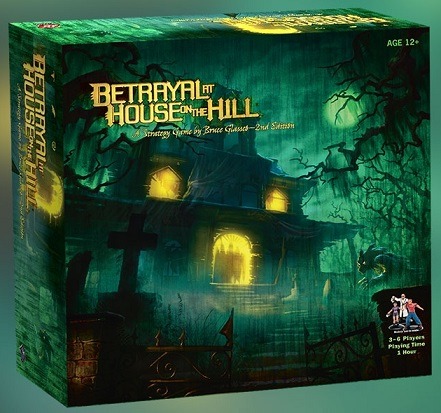
Players: 3 to 6 players, ideal for 5 or 6
Playing time: 60 minutes
Complexity/Ages: 12+
At first glance, Betrayal at House on the Hill is a very similar game to Mansions of Madness: a group of players arrives at an unexplored house.
Initial exploration
Moving through the three floors (ground floor, basement, upper floor), players explore new (randomly drawn) tiles, pick up items, use items, and get Omen cards and event cards.
Event cards have a narrative text on them, which you read after you pick them up and it will tell you what to do (or you must make a decision). Omen cards are what makes this game special: each time you pick up a special Omen card a Haunt roll must be performed.
This is a dice roll, which decides whether should the Haunt begin yet. If you roll less than the total number of Omen cards in the game, the Haunt starts. So, if more of those are in-game, the more likely that the Haunt will start.
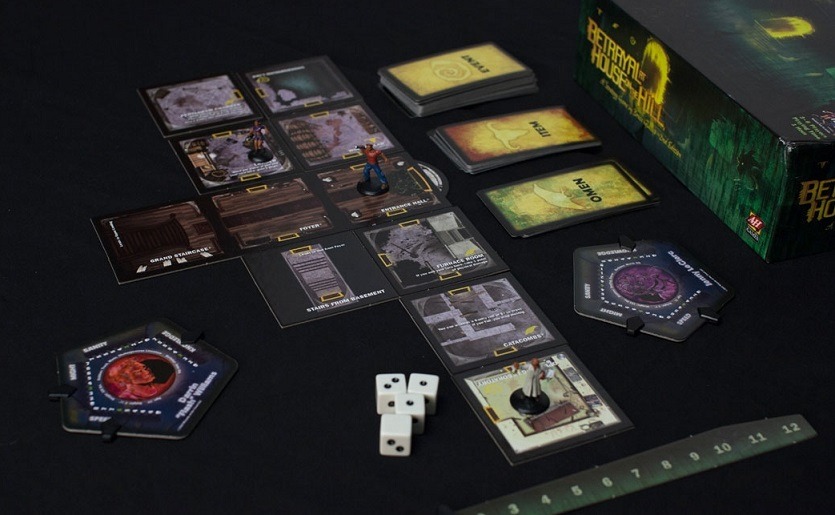
The tables have turned
The Haunt is a concept unique to this game. Depending on the current game’s parameters (what has been explored so far, items in-game, etc.), the game instructions determine the scenario of the Haunt and who the betraying player is.
This player then receives special instructions, telling him how the scenario will play out and what his victory conditions are. On the other side, players receive similar instructions, telling them how to work together to stop the betraying player and how they can win the game.
What usually happens is that the betraying player gets additional powers and can summon monsters, with which he fights other players, either to kill them or to gain possession of an item they obtain. In tactical combat, players fight him, try to defeat him, and stop him. But there are different scenarios, so don’t expect any two games to be the same.
A unique mixture of coop and one-vs-many
Although nothing too special about the first stage (especially if you compare it to mansions of Madness), it’s the twist for the second stage, which gives this game a purpose and a place on the market.
You can never be too relaxed in the exploration phase: constantly worrying about that weapon or item your fellow player just got – will it help you or work against you? You better stock up yourself as well, you never know on which side of Betrayal at House on the Hill you will end.
Read about Betrayal Legacy, a campaign version of the game
Bonus entry: Horrified
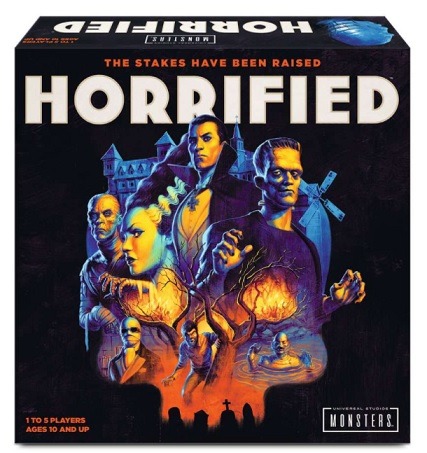
Players: 1-5, best with 3
Playing time: 60 minutes
Complexity/Ages: 10+
Theme and Setting
In Horrified, you play as heroes who must save the village from iconic horror monsters: Frankenstein, The Bride of Frankenstein, The Wolf Man, Dracula, The Mummy, The Invisible Man, and Creature from the Black Lagoon.
Monsters come with miniatures and the board embraces the black-and-white movie technique perfectly, although it uses crimson and yellow tones. The immersion in the theme is perfect – it’s like being one of those guys with torches and pitchforks, hunting down Frankenstein’s Monster.
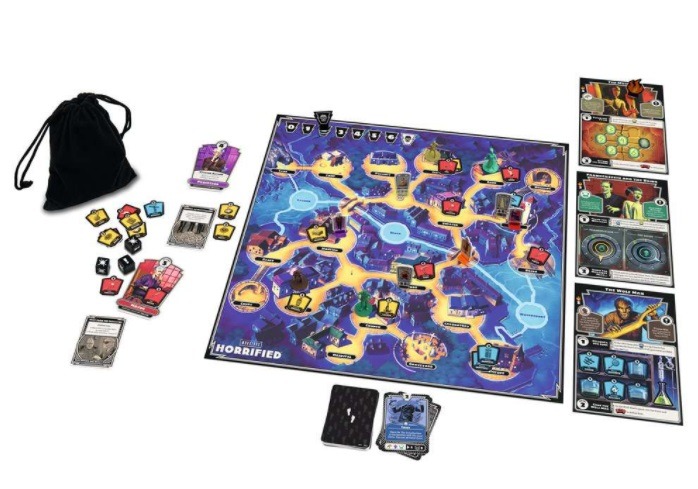
Plenty of set-up variables are available
You start the game by selecting the monsters. On normal difficulty, you face 3 (you can change the difficulty by adding/removing monsters). The heroes (professor, mayor, courier, scientist, archeologist, explorer, and inspector) you pick all come with a special ability and several action points. There are a lot of hero/monster combos, making the replay factor quite high and also offering various difficulties.
Action points and items
On your turn, you will spend your action points to move your hero, escort villagers out of harm’s way, pick up or trade items, advance a monster’s task, or finally defeat it.
Collecting items and then carrying them somewhere else to use them (to accomplish the monster’s tasks, which eventually makes it possible to kill it), is the core of the Horrified gameplay.
Different monsters require different thematic tasks to defeat them – i.e. you have to smash Dracula’s coffins on the map. There are several types of items scattered around, so collecting and trading with others is essential when producing required combinations.
Monsters’ turn
After the player’s turn, you draw a monster card, which tells you how many items will be added to the board, possible events, and which monsters move and attack (sometimes resolved with a die roll). Attacking a hero makes them discard an item while attacking a villager will kill him, increasing the terror track.
The game ends when all monsters are defeated, the terror track reaches the end, or the monster deck runs out of cards.
Conclusion
As you can see, all of these games are cooperatively aligned. It’s because I believe cooperative play is one of the best ways to experience thematic board games, as it gives you a feeling of going on an adventure together, discovering things, and fighting enemies.
Most of the games on the list also come with plenty of expansions, so if you like a particular title, there are options to delve in deeper and enhance your experience. Click on links to see more.
Recommendations
But if I would have to recommend just one title on the list, it would be Mansions of Madness – click here to check out the price on Amazon – its depth, narrative scenarios, and the app making all this possible are unparalleled.
If you’re on a budget, I suggest picking up Horrified as it’s the best bang for your buck.
Has any of the games on my list spurred an interest in you? What do you think about them and Halloween in general? Leave your comments below.
Further reading:

Well, this is really great because i have been looking for great game ideas for my Halloween party. Seeing this is very good for me because i can enjoy maybe one or two. Looking at this list, i think i will go for Zombicide but I can’t seem to find another better one that catches me.
Killing zombies is always fun, I’m sure you won’t go wrong! 🙂
Mysterium is my number one pick from this list and though I don’t restrict myself only to playing it in the halloween but almost every time. I love the air of mystery blended with fun around it. Simply interesting one to see from here. Thanks so much for listing all these games. They would serve as alternatives to go to during halloween and to make the moments more special and lovely. Thanks
I am glad I’ve been helpful and you liked the article. Thank you too.
One thing u really like about board game is that it’s has this way of bringing people together and I’ve been playing different types for a very long time. These board games that you’ve listed here are really nice and also coupled with the fact that it’s Halloween oriented makes it more themed and it’s going to be fun. I’ll share with my wife and my girls so I’ll hear their view on which one to buy. Thanks for the help.
Thanks for the comment. I believe cooperative board games bring people even closer together (than competitive), so I think coop is the way to go for family nights!
Wow! good listing you have put up here and I like every bit of it. this is simply awesome to see here and I like it. There is simply nothing bad making he halloween more fun filled than just appearing in costumes but by including games as these, it would be more fun and awesome. Thank you so much for this. I think I like the Ghost stories and Mysterium more from the list and would surely try to get them
Thanks for the comment. Ghost Stories are a bit more challenging, but Mysterium is perfect for a Halloween night!
Hey Vasillij
Thanks so much for sharing a good list of Halloween Board Games, weather will be cold and with some rain so your article is a good timing for me to find a way to stay at home tomorrow night, waiting for the kids, we don’t expect many, but just a few will stop to get their candies.
Nothing better to do that to play a board game while waiting, as my husband and I know it’s better to wait for the kids right next to the door.
Ghost Stories and Mansion of Madness are my picks, as both games can be played with one player or more!
Weather here is also rainy and cold, so we’re likely to stay in too.
Board games with single player mode are not a bad choice if you have trouble getting more players.
Great Halloween fun. I like the idea of working together to reach the goal or free the ghost. Some of them look like a modern horror version of Ludo. I should imagine My kids would prefer the Mansions of Madness game as it is almost impossible to pull them away from their mobile devices. My Eldest son is heavily in to Warhammer 40K and Warhammer Fantasy so I would imagine that these could be a great way to get him to join in with the Halloween fun. If you can get the kids to enjoy the games then it is excellent that there is scope to expand them. Thanks for an informative Post Mark.
Thanks for the comment.
This article is great I have been on the lookout for some spooky board games.
My favourite picks here are Mysterium, Mansions of Madness and Betrayal at House on the Hill. I love mystery games and haunted house type genre so I was pleased to find these included in your list.
I have clicked on your link and had a better look at Mysterium I think it will be that one that I buy it has really good reviews and the game just speaks to me, excuse the ghost medium pun.
Thanks for the post!
Hehe, loved the pun! 🙂
Since am such good at playing games, I have loved this article from its beginning to its end. I have also loved seven best Halloween board games you have provided most especially I have fall in love with that of zombicide and I think it will be favorable to the rest of my family members thanks for sharing with us
As said before, killing zombies is fun! 🙂
I played Ghost stories recently at a friend’s house. I must admit I’m not really a fan of board games, but I found the game to be pretty interesting. Reading your article made think of changing my habits for Halloween this year. I and my girlfriend were thinking of getting some funny costumes but I think we prefer board game this year.
I’m sure you won’t regret getting into board gaming! New people are always welcome. 🙂
Thanks so much for your list of best family Halloween board games; It will be very useful for me this weekend. Our family has a “Family Fun Day” where the kids and I do something together each Sunday and these will be great for the upcoming Halloween weekend. The weather is starting to cool off making stay in game night a hit lots of weekends.
I very much like that you chose a cooperative theme for many of these games. Games such as this creates an atmosphere of working together instead of being pitted against each other where there is only one winner. It is great to build skills of ‘being a good sport’ in children when winning and/or losing but the whole concept changes when all the players can work toward a common cause. Thanks again!
Thank you for the comment. I am indeed a fan of cooperation games over competitive. I believe they bring out the best out of every person, instead of worse, like competitive do. Ideal for families.
I have not played any game during Halloween before but it will be very nice for me to give your ideas a tryout. I think that I will really enjoy it. You have given some very good ideas. I think all i need to do is walk into a store to get one. I do not know what a cooperative game is, can you explain that?
I guess I haven’t reall explained. 🙂
Cooperative game is a game where players form a team and work together towards a common goal. Opposing them is the game – every board games uses different mechanics for simulating this, like drawing cards etc.
On the other side of the spectrum you have competitive games. Here players compete egainst each other, trying to achieve certain goal(s) and win the game individually.
I hope that answers your question.
To be sincere, I’m not really an Halloween kind of person but these board games are interesting and I can’t really wait to lay my hands one some of them. My kids do Halloween frequently and they love it, will this game be suitable for them too?? I love having my family time regularly without being interrupted or disturbed and this board games will serve as a good activity to engage in. I commend you for sharing this article, it’s very helpful.
These games are suitable for children of around 10 and up. I have written alongside every game, what the recommended minimum age is. This also depends how many experience your kids have had with gaming.
Hello Vasillij,
Great list with interesting options for co-op play. I’m less of a co-op player who likes to be competitive, can you make a similar list for top competitive horror games? Would be interested in what you come up with. Thanks ?
From the top of my head, a game like Nemesis would certainly be on that list. It’s a semi-cooperative board game, where players are not only working together but also have personal agendas, that often require backstabbing others.